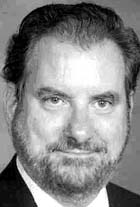Measuring Mass: From Positive Rays to Proteins:Chemical Heritage Foundation, August 2002)
As the field of mass spectrometry becomes more widely used, so does the need for a better understanding of the field among the general populace.
Michael A. Grayson, senior mass spectrometrist in chemistry in Arts & Sciences and assistant director of the mass spectroscopy facility, has attempted to do just that, by editing this recent exposition of his field.

“There is hardly any area of research in the chemical and related sciences where mass spectrometry is not used to provide scientists with information about the nature of the molecules they are working with,” Grayson said.
“Without mass spectrometry, this research would progress at a much slower rate, or in some cases, not at all. It is appropriate that the average citizen have some awareness of the importance of this tool and how it accelerates developments throughout the scientific world; developments with a direct impact on the life of each of us.
While technical reviews in journals and chapters in books written by the specialist for the specialist abound, this is one of the first attempts to bring mass spectrometry to the masses.
To accomplish this task, Grayson enlisted the help of experts in various application areas of mass spectrometry and invited them to share their views regarding the major historical developments in their specialties.
By using vignettes, sidebars, illustrations and a timeline, Grayson managed to get the point across while ensuring that the scientifically uninitiated reader would understand it.
“I wanted to create something different, something that would be accessible to the non-expert yet be of value to the expert as well,” Grayson said. “Perhaps the best way of describing my goal was stated by one of the contributors to the book: ‘I want a book that I can give to my mother so she can understand what I do.’
“Hopefully, Measuring Mass will do that.”
However, the book will also provide valuable insight to those embedded within the field.
“Many mass spectrometrists come from other scientific disciplines,” Grayson said. “Hence they use the tool with an extensive knowledge of the background of the technique in their specialty. However, they don’t have an appreciation for the overall development of the field and how contributions from a decade or two or three ago have a direct impact on how they use mass spectrometry today.
“Measuring Mass is a means of telling the story of mass spectrometry starting with the discovery of the electron over a century ago thus setting their own use of the tool in a larger context.”
— Andy Clendennen